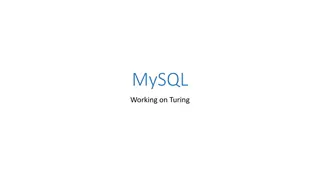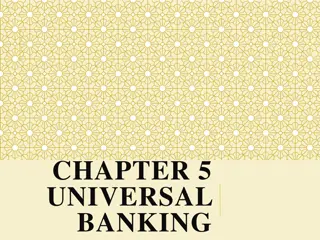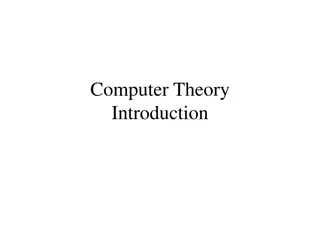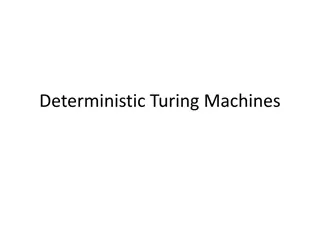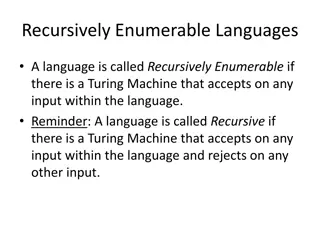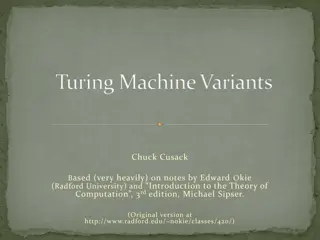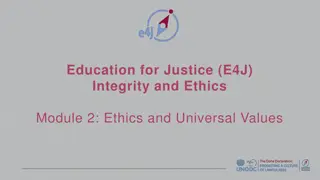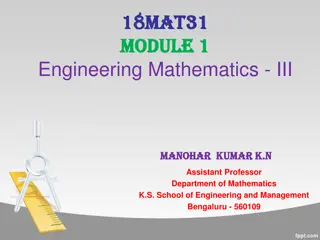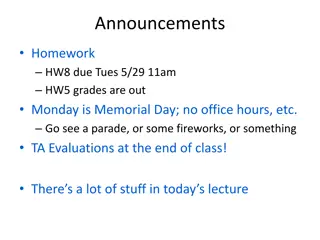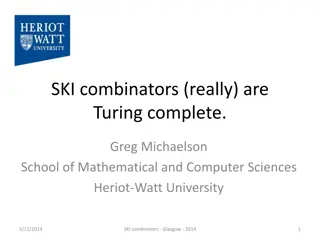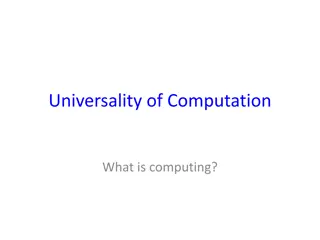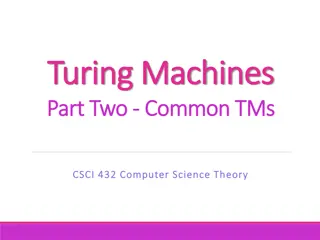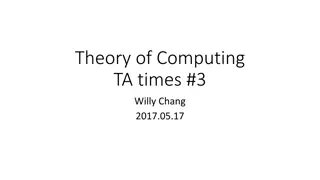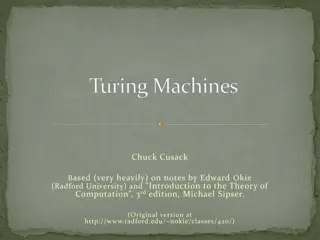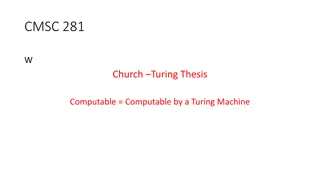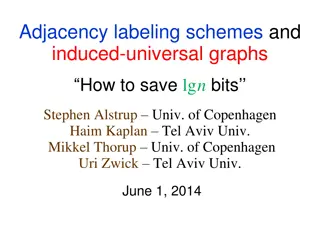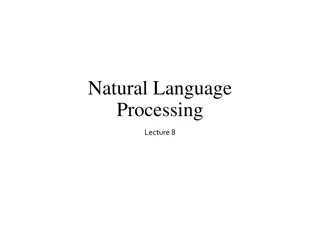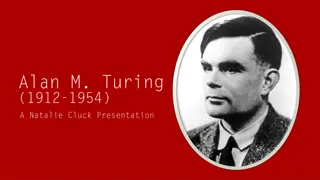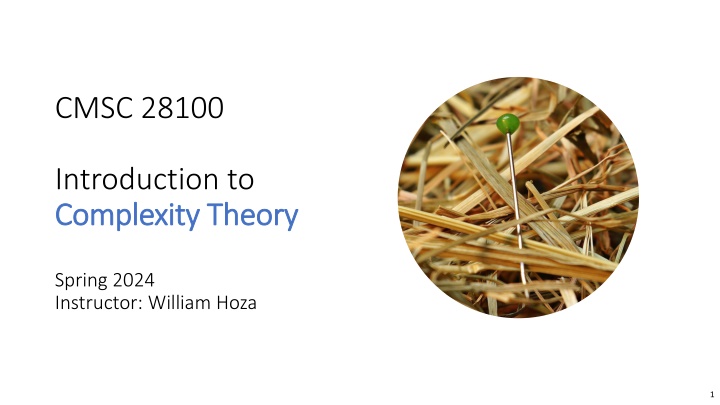
Understanding Complexity Theory and Turing Machines
Explore the fundamentals of Complexity Theory and the concept of Turing machines through Python scripts and the Church-Turing Thesis. Discover the encoding of Turing machines as strings and how they relate to modern computing devices like laptops.
Download Presentation

Please find below an Image/Link to download the presentation.
The content on the website is provided AS IS for your information and personal use only. It may not be sold, licensed, or shared on other websites without obtaining consent from the author. If you encounter any issues during the download, it is possible that the publisher has removed the file from their server.
You are allowed to download the files provided on this website for personal or commercial use, subject to the condition that they are used lawfully. All files are the property of their respective owners.
The content on the website is provided AS IS for your information and personal use only. It may not be sold, licensed, or shared on other websites without obtaining consent from the author.
E N D
Presentation Transcript
CMSC 28100 Introduction to Complexity Theory Complexity Theory Spring 2024 Instructor: William Hoza 1
Python script Turing machine Basic idea: Variable Tape (assuming the variable holds a list of bits) List index Head Line of code State 2
Turing machines as a programming language You can think of the Turing machine model as a primitive programming language From a programming perspective, the model is extremely inconvenient and annoying, because it has so few features! However, our goal is to prove impossibility results The model has few features, which will make our lives easier, not harder 3
The Church-Turing Thesis Let ? be a language Church-Turing Thesis: There exists an algorithm / procedure for figuring Intuitive notion out whether a given string is in ? if and only if there Mathematically precise notion exists a Turing machine that decides ?. 4
Turing machines vs. your laptop OBJECTION: My laptop is a single device that can run arbitrary computations. I don t use one laptop for email, a second laptop for Zoom, a third laptop for Tetris, and a fourth laptop for photo editing. I just use one laptop for everything. In contrast, a single Turing machine only solves one problem. If ?decides one language, then it can t also decide a different language. Therefore, Turing machines don t properly model my laptop. 5
Code as data The response to this objection is based on the principle of viewing code as data A Turing machine ? can be encoded as a string ? 6
Encoding a Turing machine as a string Example: Problem set 1, problem 4 turing-machine.json {"a": {">": null, "_": ["o", "_", "R"], "0": ["b", "_", "R"], "1": ["c", "_", "R"], "#": ["d", "_", "R"], "$": null, "&": null, "%": null}, "b": {">": null, "_": ["o", "0", "R"], "0": ["b", "0", "R"], "1": ["c", "0", "R"], A text file (string) that encodes a Turing machine 7
Encoding a Turing machine as a string For a Turing machine ? = ?, , , , ,?,?0,?accept,?reject, we could define ? 0,1,#,&,$,% as follows Assume WLOG that ? = 0,1,2, ,? and = ? + 1, ,? + ? Assume WLOG that ?0= 0; ?accept= ? 1; and ?reject= ? Assume WLOG that = ? + 1; = ? + 2; and = ? + 3,? + 4, ,? + 2 + ? We let ? = ? # ? # ? # ? , where ? is the list of all entries in the transition table, where rows are separated by & symbols, cells within a row are separated by $ symbols, and the individual components of each entry are separated by % symbols 8
Analyzing a given Turing machine Given the encoding ? of a Turing machine ?, one can try to answer various questions about ? How many states does ? have? How big is the tape alphabet of ?? Does ? accept ###11 within 10000 steps? 9
@weight(0.5) @number("3") def test3(self): """Run the machine on input ###11""" val = simulate(self.transition, "###11", 10000) self.assertEqual(val, "Accept") Analyzing TMs Example: The def simulate(transition, input, steps): SYMBOLS = [">", "_", "0", "1", "#", "$", "&", "%"] STATES = ["a", "b", "c", "d", "e", "f", "g", "h", "i", "j", "k", "l", "m", "n", "o", "p"] autograder for state = STATES[0] tape = [SYMBOLS[0]] + list(input) headPosition = 1 problem set 1, for i in range(steps): if (headPosition >= len(tape)): tape.append(SYMBOLS[1]) problem 4 symb = tape[headPosition] arr = transition[state][symb] if arr == None: return "No transition available" state = arr[0] tape[headPosition] = arr[1] headPosition = headPosition + 1 if arr[2] == "R" else headPosition - 1 10
Simulating one step For every Turing machine ? and configuration ? of ?, define STEP ?,? = ?,NEXT ? Lemma: There exists a Turing machine ? that computes STEP. That is, given ?,? as input, the machine ? halts, and its final configuration is ?acceptSTEP ?,? , possibly followed by some number of symbols. (Proof left as an exercise) 11
Universal Turing machines What is the universal Turing machine s input alphabet? A: A fixed, constant-size alphabet that doesn t depend on anything B: Whatever ? s input alphabet is C: The union of ? s input alphabet D: The union of all possible alphabets Theorem: There exists a Turing machine ?such that for every Turing and the alphabet for encoding ? Respond at PollEv.com/whoza or text whoza to 22333 machine ? and every input ?: If ? accepts ?, then ? accepts ?,? . If ? rejects ?, then ? rejects ?,? . If ? loops on ?, then ? loops on ?,? . Proof sketch: (1) Construct ? = ?0?. (2) Alternate between updating ? NEXT(?) and checking whether ? is a halting configuration 12
Universal Turing machines A universal Turing machine can be programmed to do anything that is computationally possible This is why you don t need separate laptops for separate computational tasks If you are stranded on an alien planet and you are trying to build a computer, your job is to build a universal Turing machine 13
The Church-Turing Thesis Let ? be a language Church-Turing Thesis: There exists an algorithm / procedure for figuring Intuitive notion out whether a given string is in ? if and only if there Mathematically precise notion exists a Turing machine that decides ?. 14
Note on standards of rigor Going forward, when we want to construct a Turing machine (e.g., for an existence proof), we will simply describe what it does in plain English, as if we are giving instructions to a human being Each plain English description can be formalized as a Turing machine, but this is tedious You should follow this convention on problem set 3 and beyond Nevertheless, the Turing machine model is extremely valuable for us, because it tells us what an arbitrary algorithm looks like! 15
Which problems Which problems can be solved can be solved through computation? through computation? 16
What are Turing machines What are Turing machines capable of? capable of? 17
What are Turing machines What are Turing machines NOT capable of? NOT capable of? 18
Decidable and undecidable Let ? be a language We say that ? is decidable if there exists a Turing machine ? that decides ? Otherwise, we say that ? is undecidable 19
Computability vs. Complexity For now, we don t care how long it takes to decide ? Computability Theory. Possible vs. Impossible As long as ? has a finite running time on every input, we re satisfied Later, we will study what happens when we do care how long it takes Complexity Theory. Tractable vs. Intractable We will also consider other computational resources besides time 20
Which languages are decidable? Which languages are decidable? 21

